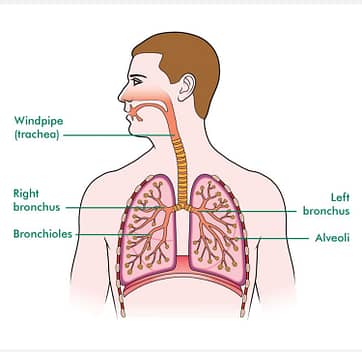This is the first of a 4 part series on lungs and lung health.

Table of Contents
Parts of our respiratory system
- The nose and mouth
- The trachea or the windpipe
- The bronchi or 2 tubes that branch out into each of the lungs
- The lungs which are spongy air filled organs on either side of the chest. These also contain:
- Bronchioles which are offshoots of the bronchi and
- Alveoli which are microscopic air sacs. The main action happens here.
- Between the alveoli, there is a thin layer of cells called the interstitium which has blood vessels that support the alveoli.
- Pleura is a thin membrane that covers the lungs and also lines the inside of the lung cavity.
How does the respiratory system function
As we breathe in through the mouth and nose, the air moves down the trachea, to the bronchi to the bronchioles to the alveoli. Here, the oxygen is absorbed into the blood. which then is circulated to the rest of the body.
On the flip side, de-oxygenated blood reaches the lungs, where carbon dioxide is transferred to the alveoli and the course is reversed, ending with the release of carbon dioxide out into the atmosphere.
Muscles that help in breathing

The lungs have no muscles of their own. The muscles involved in breathing are the diaphragm, the intercostal muscles that lie between the ribs, the muscles in the neck and abdominal muscles. Breathing is facilitated by breathing pump muscles. These are primarily muscles attached to the rib cage.
There are 2 kinds of muscles:
- Inspiratory muscles, or those that help with inspiration or breathing in. These expand the thoracic or chest cavity. The primary inspiratory muscles are the diaphragm and external intercostals of the ribs.
- Expiratory muscles, or those that help with expiration or breathing out. These compress the chest cavity. Normal expiration happens in a relaxed manner and is a passive process. For forced expiration, certain muscles of the ribs and abdomen are involved.
Characteristic of these muscles
- They are ‘fatigue resistant’
- They are involuntary as well as voluntary, so even when we are not thinking about it, we keep breathing.
Examples of Lung Problems
Problematic conditions arise when any part of the respiratory system is not functioning properly. Common conditions include:
- Chronic Obstructive Pulmonary Disease (COPD) is when the lungs are damaged, affecting exhalation. This is usually caused by smoking.
- Asthma is when the bronchi are inflamed due to allergens, air pollution, irritants. Symptoms include shortness of breath and wheezing.
- Emphysema is a form of COPD in which the alveolar sacs are damaged, preventing normal transfer of gases with the blood.
- Pneumonia is an infection of one or both lungs, and can be bacterial or viral.
- Acute bronchitis is a viral infection of the bronchi, primarily causing cough.
- Chronic Bronchitis is a form of COPD that brings about a chronic wet cough.
- Cystic Fibrosis is a hereditary disease in which there is a buildup of mucus in the bronchi that is difficult to get rid of, leading to recurring lung infections.
- Pleurisy is a condition in which the pleura gets inflamed, causing pain, especially during breathing.
- Interstitial Lung disease includes a few different conditions affecting the interstitium, the thin lining between the alveoli.
- Tuberculosis is an infectious bacterial disease of the lungs.
- Pulmonary Embolism is when a blood clot travels to the lungs and sticks to a pulmonary artery. This is a serious condition.
- Pulmonary hypertension is high blood pressure of the pulmonary arteries, caused by different health conditions.
What can you do to keep your lungs in good functioning order?
- Don’t smoke or stop smoking. You can slow down the progression of COPD by doing that.
- Avoid exposure to indoor and outdoor pollutants.
- Practice good hygiene to help you prevent infections.
- Have regular checkups.
- Exercise regularly—both aerobic and muscle-strengthening exercises will strengthen your breathing system.
- Look up my post on Exercise Recommendations.
- In addition, breathing exercises can help strengthen your lungs and breathing apparatus.
Sources:
www.physio-pedia.com
www.webmd.com/lung
www.merckmanuals.com/home/lung-and-airway-disorders
“Journey to Health with Priya” provides general educational information on various topics on this website as a public service, which should not be construed as professional medical advice nor be used as a substitute for direct medical advice from your doctor or other qualified clinician.


Thank you for this wonderful information on the lungs. I am going to check out the breathing exercises.
Thanks Laurie. I will be posting a few more posts related to lung health in which I will probably include more exercises. Be on the lookout for those.